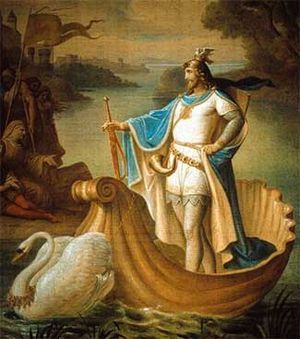Lohengrin

Lohengrin (Middle High German: Loherangrîn) is, according to Wolfram von Eschenbach's verse epic "Parzival", a Grail knight and son of the Grail King Parzival and his wife Condwiramur. As a swan knight, he is sent to the Duchess of Brabant on a swan as a helper and protector, on the condition that she never ask his name. When she breaks this strict commandment, Lohengrin must leave her[1].
The material was given a musical dramatic form by Richard Wagner in his romantic opera "Lohengrin".
Spiritual background
„The time when the Grail legend came into being under the influence of the great initiates is that when the rule of the bourgeoisie begins and when from Scotland in England and from there in France and Germany the foundation of the great free cities spreads. Man who has become free unconsciously longs for truth and for divine life. In the saga of Lohengrin, Elsa represents the human soul, the soul of the Middle Ages, which strives for unfoldment and which in occultism is always represented by a female figure. The knight Lohengrin, who comes to her liberation from an unknown world, from the castle of the Holy Grail, represents the Master who brings the truth. He is the messenger of the Initiate, symbolically brought by the swan. The messenger of the great initiates is called "Swan". One must not ask about its origin or its true name. One must not doubt the signs of his majesty. One must believe his word and recognise the ray of truth in his countenance. He who does not have this faith is not able to comprehend him and not worthy to hear him. Hence Lohengrin's prohibition of Elsa from asking his origin and his name. The swan is the chela that summons the master.
The messenger of the Master on the physical plane is the initiated disciple who has ascended to the fifth degree and whom the Master sends into the world. This is how this legend expresses what happens in the higher worlds. Into the myths and legends the Logos, the Sun and Planetary Word, lets its light shine.“ (Lit.:GA 94, p. 84f)
Literature
- Rudolf Steiner: Kosmogonie, GA 94 (2001), ISBN 3-7274-0940-1 English: rsarchive.org German: pdf pdf(2) html mobi epub archive.org
 |
References to the work of Rudolf Steiner follow Rudolf Steiner's Collected Works (CW or GA), Rudolf Steiner Verlag, Dornach/Switzerland, unless otherwise stated.
Email: verlag@steinerverlag.com URL: www.steinerverlag.com. Index to the Complete Works of Rudolf Steiner - Aelzina Books A complete list by Volume Number and a full list of known English translations you may also find at Rudolf Steiner's Collected Works Rudolf Steiner Archive - The largest online collection of Rudolf Steiner's books, lectures and articles in English. Rudolf Steiner Audio - Recorded and Read by Dale Brunsvold steinerbooks.org - Anthroposophic Press Inc. (USA) Rudolf Steiner Handbook - Christian Karl's proven standard work for orientation in Rudolf Steiner's Collected Works for free download as PDF. |
